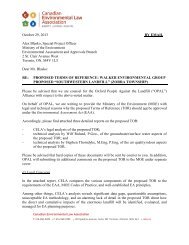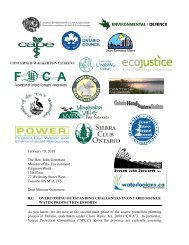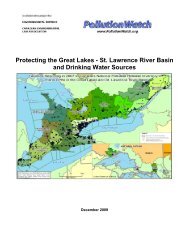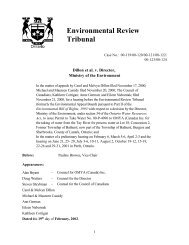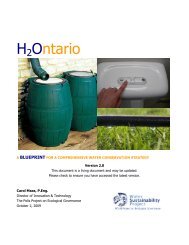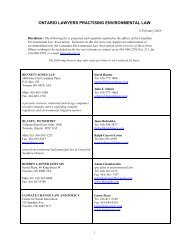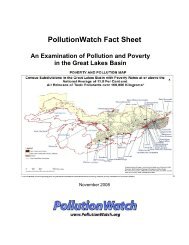Regulating Toxic Substances in Consumer Products - Canadian ...
Regulating Toxic Substances in Consumer Products - Canadian ...
Regulating Toxic Substances in Consumer Products - Canadian ...
Create successful ePaper yourself
Turn your PDF publications into a flip-book with our unique Google optimized e-Paper software.
<strong>Regulat<strong>in</strong>g</strong> <strong>Toxic</strong> <strong>Substances</strong> <strong>in</strong><br />
<strong>Consumer</strong> <strong>Products</strong><br />
Response to the Discussion Paper on<br />
Canada’s Food and <strong>Consumer</strong> Safety Action Plan<br />
Submitted to:<br />
Corporate Consultation Secretariat<br />
Health Canada<br />
PL 1904D<br />
Room 496D, Jeanne Mance Build<strong>in</strong>g<br />
200 Eglant<strong>in</strong>e Driveway<br />
Ottawa, ON K1A 0K9<br />
delivered via email to: <strong>in</strong>fo@hc-sc.gc.ca and fax: 613-948-8092<br />
Prepared by:<br />
Kathleen Cooper<br />
Theresa McClenaghan<br />
February 13, 2008<br />
CELA Publication No. 599<br />
ISBN #978-1-897043-73-8<br />
CANADIAN ENVIRONMENTAL LAW ASSOCIATION<br />
L’ASSOCIATION CANADIENNE DU DROIT DE L’ENVIRONNEMENT<br />
130 SPADINA AVENUE • SUITE 301 • TORONTO • ONTARIO • M5V 2L4<br />
TEL: 416/960-2284 • FAX: 416/960-9392 • www.cela.ca
<strong>Regulat<strong>in</strong>g</strong> <strong>Toxic</strong> <strong>Substances</strong> <strong>in</strong> <strong>Consumer</strong> <strong>Products</strong><br />
Response to the<br />
Discussion Paper on Canada’s Food and <strong>Consumer</strong> Safety Action Plan<br />
Contents<br />
Background on CELA......................................................................................................... 2<br />
Scope of CELA’s Comments <strong>in</strong> Response to the proposed Action Plan............................ 2<br />
Background – <strong>Toxic</strong> Chemicals Orig<strong>in</strong>at<strong>in</strong>g <strong>in</strong> <strong>Consumer</strong> <strong>Products</strong>.................................. 2<br />
The Example of Phthalates ................................................................................................. 4<br />
Four Federal Laws Affect<strong>in</strong>g <strong>Products</strong> – Gaps, Uncoord<strong>in</strong>ated and Inconsistent<br />
Approaches ......................................................................................................................... 8<br />
Regulation of <strong>Products</strong>; Regulation of Trade ..................................................................... 9<br />
The Proposed General Prohibition.................................................................................... 11<br />
The Need for Law Reform and Coord<strong>in</strong>ation................................................................... 12<br />
Reactive Measures to Address <strong>Consumer</strong> <strong>Products</strong>.......................................................... 15<br />
Proactive Measures to Address <strong>Consumer</strong> <strong>Products</strong> ........................................................ 16<br />
Conclusion ........................................................................................................................ 18<br />
1
Background on CELA<br />
The <strong>Canadian</strong> Environmental Law Association (CELA) is a non-profit, public <strong>in</strong>terest<br />
organization founded <strong>in</strong> 1970. CELA is an environmental law cl<strong>in</strong>ic – with<strong>in</strong> Legal Aid<br />
Ontario - dedicated to provid<strong>in</strong>g legal services to low <strong>in</strong>come people and disadvantaged<br />
communities, and advanc<strong>in</strong>g the cause of strong environmental protection through<br />
advocacy, education and law reform.<br />
In addition to provid<strong>in</strong>g direct legal representation and summary advice, CELA's law<br />
reform and public educational mandates <strong>in</strong>clude advocacy on ensur<strong>in</strong>g access to<br />
environmental justice and protect<strong>in</strong>g public environmental rights. This work occurs at the<br />
local, regional, prov<strong>in</strong>cial, national and <strong>in</strong>ternational level.<br />
Scope of CELA’s Comments <strong>in</strong> Response to the proposed Action Plan<br />
We provide general comments here on the proposed Action Plan. However, <strong>in</strong> the three<br />
areas <strong>in</strong>cluded (Food <strong>Products</strong>, Health <strong>Products</strong> and <strong>Consumer</strong> <strong>Products</strong>) we focus most<br />
of our comments <strong>in</strong> the area of consumer products. For the reasons noted here<strong>in</strong>, we also<br />
<strong>in</strong>clude discussion of complementary product-focused reforms to the <strong>Canadian</strong><br />
Environmental Protection Act.<br />
Background – <strong>Toxic</strong> Chemicals Orig<strong>in</strong>at<strong>in</strong>g <strong>in</strong> <strong>Consumer</strong> <strong>Products</strong><br />
Members of our staff have worked on issues of consumer product safety for many years,<br />
particularly with respect to <strong>in</strong>vestigat<strong>in</strong>g the risks to prenatal and child health from<br />
chronic exposures to low levels of lead, phthalates, flame retardants, bisphenol A and<br />
fluor<strong>in</strong>ated chemicals. We are also extensively <strong>in</strong>volved <strong>in</strong> efforts to reduce exposure<br />
risks to known and suspected carc<strong>in</strong>ogens <strong>in</strong> the environment and consumer products and<br />
to progressively elim<strong>in</strong>ate persistent organic pollutants.<br />
In 2000, a report by CELA and the Ontario College of Family Physicians <strong>in</strong>cluded a<br />
detailed analysis of the shortcom<strong>in</strong>gs of the Hazardous <strong>Products</strong> Act <strong>in</strong> general, and the<br />
regulation of lead <strong>in</strong> consumer products and pesticides, <strong>in</strong> particular. 1 S<strong>in</strong>ce that time, we<br />
have been at the forefront of <strong>Canadian</strong> activity summariz<strong>in</strong>g the research about the<br />
greater exposure and vulnerability of children to toxic chemicals. 2<br />
For chemicals that orig<strong>in</strong>ate <strong>in</strong> consumer products, <strong>in</strong>creas<strong>in</strong>g evidence po<strong>in</strong>ts to <strong>in</strong>door<br />
1 CELA-OCFP, 2000. Environmental Standard-Sett<strong>in</strong>g and Children’s Health. Jo<strong>in</strong>t Project of the<br />
<strong>Canadian</strong> Environmental Law Association and the Ontario College of Family Physicians Environmental<br />
Health Committee. On-l<strong>in</strong>e at: www.cela.ca<br />
2 See e.g., Cooper et al, for Toronto Public Health, Environmental Threats to Children: Understand<strong>in</strong>g the<br />
Risks; Enabl<strong>in</strong>g Prevention, 2005; and <strong>Canadian</strong> Partnership for Children’s Health and Environment, Child<br />
Health and the Environment – A Primer, 2005. www.healthyenvironmentforkids.ca<br />
2
air, surfaces, <strong>in</strong>clud<strong>in</strong>g surfaces of food or water conta<strong>in</strong>ers, and especially household<br />
dust as important exposure media. Releases occur dur<strong>in</strong>g normal use, and can often<br />
<strong>in</strong>crease over time as products age. Chemicals found <strong>in</strong> house dust and <strong>in</strong>door air can<br />
<strong>in</strong>clude (but are not limited to) fluor<strong>in</strong>ated chemicals, phthalates, brom<strong>in</strong>ated flame<br />
retardants, nonylphenol ethoxylates, parabens, volatile organic compounds, organot<strong>in</strong>s,<br />
and numerous additional metals <strong>in</strong>clud<strong>in</strong>g lead and mercury, along with pesticides. The<br />
sources of many of these chemicals <strong>in</strong>clude a wide array of products on the <strong>Canadian</strong><br />
market <strong>in</strong>clud<strong>in</strong>g baby and children’s products, toys, cosmetics and personal care<br />
products, cookware, food conta<strong>in</strong>ers and packag<strong>in</strong>g materials, household cleaners,<br />
build<strong>in</strong>g materials, home ma<strong>in</strong>tenance products, furniture and fabrics, art materials and<br />
many different k<strong>in</strong>ds of electronic equipment. 3<br />
Many recent biomonitor<strong>in</strong>g studies, <strong>in</strong>clud<strong>in</strong>g robust population-based surveys conducted<br />
by the US Centers for Disease Control, reveal widespread human exposure to multiple<br />
chemicals. 4 There is also <strong>in</strong>creas<strong>in</strong>g understand<strong>in</strong>g that consumer products are a<br />
significant source of exposure to the toxic burden of all <strong>Canadian</strong>s, a burden that<br />
biomonitor<strong>in</strong>g results show is disproportionately higher <strong>in</strong> children than adults. These<br />
studies reveal body burdens of phthalates, flame retardants, fluor<strong>in</strong>ated chemicals, metals<br />
and pesticides. Biomonitor<strong>in</strong>g also reveals body burdens of banned or severely restricted<br />
chemicals <strong>in</strong>clud<strong>in</strong>g PCBs, diox<strong>in</strong>s and organochlor<strong>in</strong>e pesticides. A common feature of<br />
most of these chemicals is their presence <strong>in</strong> consumer products.<br />
In addition to a longstand<strong>in</strong>g focus on the impact on children of chemicals <strong>in</strong> consumer<br />
products, CELA has been closely <strong>in</strong>volved <strong>in</strong> the implementation and ongo<strong>in</strong>g<br />
parliamentary review of the <strong>Canadian</strong> Environmental Protection Act, 1999 (CEPA). 5<br />
That work has consistently revealed <strong>in</strong>adequate regulation of chemicals that are deemed<br />
toxic under CEPA and also found <strong>in</strong> consumer products, particularly <strong>in</strong> imported<br />
products. While some regulatory action has occurred with<strong>in</strong> product-specific regulations<br />
established under CEPA, and under the Hazardous <strong>Products</strong> Act, large gaps rema<strong>in</strong> <strong>in</strong><br />
terms of adequate regulation of toxic chemicals <strong>in</strong> products and between these two<br />
federal statutes. Further, it is necessary to address gaps and improve coord<strong>in</strong>ation with<br />
the Food and Drugs Act as the example of phthalates, discussed below, illustrates.<br />
To address persistent organic pollutants <strong>in</strong> consumer products, we have been closely<br />
<strong>in</strong>volved <strong>in</strong> the six-year effort to categorize substances on the Domestic <strong>Substances</strong> List<br />
3 Cooper, K, K Khatter and J Catrilli, 2007. Us<strong>in</strong>g the <strong>Canadian</strong> Environmental Protection Act to Regulate<br />
<strong>Toxic</strong> <strong>Substances</strong> <strong>in</strong> <strong>Products</strong>. Lessons learned from two cases studies – lead and phthalates. Report<br />
prepared for Health Canada.<br />
4 The 1 st , 2 nd and 3 rd reports of the National Biomonitor<strong>in</strong>g Program are posted on-l<strong>in</strong>e by the Centers for<br />
Disease Control at: http://www.cdc.gov/biomonitor<strong>in</strong>g/<br />
5 CELA and Environmental Defence (Pollution Watch): Perfluor<strong>in</strong>ated <strong>Substances</strong> and the <strong>Canadian</strong><br />
Environmental Protection Act (CEPA). Submission to the Senate Stand<strong>in</strong>g Committee for Energy, the<br />
Environment and Natural Resources, February 20, 2007; Legislative Overlap and Interdepartmental<br />
Jurisdiction with respect to <strong>Consumer</strong> <strong>Products</strong> and the In Commerce List, Remarks for a presentation to<br />
the Parliamentary Review of the <strong>Canadian</strong> Environmental Protection Act, 1999, December 11, 2006;<br />
Reform<strong>in</strong>g the <strong>Canadian</strong> Environmental Protection Act<br />
Submission to the Parliamentary Review of CEPA, 1999, June, 2006. On-l<strong>in</strong>e <strong>in</strong> “Review<strong>in</strong>g CEPA”<br />
collection at: http://www.cela.ca/coreprograms/detail.shtml?x=2139<br />
3
as well as work<strong>in</strong>g closely with colleagues <strong>in</strong> the International POPs Elim<strong>in</strong>ation<br />
Network <strong>in</strong> efforts to implement, and expand the chemicals covered by, the Stockholm<br />
Convention on POPs. We are very supportive of current efforts to expand the POPs<br />
Treaty via nom<strong>in</strong>ation of n<strong>in</strong>e chemicals, or chemical groups, by the European<br />
Commission 6 most of which are <strong>in</strong> consumer products <strong>in</strong>clud<strong>in</strong>g several flame retardants,<br />
polychlor<strong>in</strong>ated naphthalenes, used for cable <strong>in</strong>sulation, and short-cha<strong>in</strong>ed chlor<strong>in</strong>ated<br />
paraff<strong>in</strong>s used <strong>in</strong> metal work<strong>in</strong>g and leather f<strong>in</strong>ish<strong>in</strong>g.<br />
With<strong>in</strong> the Parliamentary Review of CEPA, we have called for the use of CEPA to<br />
address toxic substances <strong>in</strong> consumer products s<strong>in</strong>ce this law provides a comprehensive<br />
legal tool to address this grow<strong>in</strong>g problem <strong>in</strong>sofar as it has an overarch<strong>in</strong>g mandate for<br />
the prevention of harm and the protection of environment and human health. CEPA<br />
provides for tools that can <strong>in</strong>fluence and/or regulate the use of substances across their<br />
entire life cycle, <strong>in</strong>clud<strong>in</strong>g <strong>in</strong> products. Application of both the Hazardous <strong>Products</strong> Act<br />
and the Food and Drugs Act end with product use and are thus far more limited <strong>in</strong><br />
comparison. The potential toxicity of chemicals <strong>in</strong> consumer products exists prior to their<br />
use <strong>in</strong> products and can extend beyond product use to disposal, especially if they are<br />
persistent or bioaccumulative. Occupational exposures, environmental emissions and<br />
waste management options, whether dur<strong>in</strong>g reuse or recycl<strong>in</strong>g, <strong>in</strong>c<strong>in</strong>eration or landfill,<br />
present cont<strong>in</strong>ued opportunities for these substances to exert toxic effects on humans or<br />
the environment <strong>in</strong>clud<strong>in</strong>g as metabolites or products of physical/chemical breakdown or<br />
combustion.<br />
In its report on public hear<strong>in</strong>gs <strong>in</strong>to CEPA, the Stand<strong>in</strong>g Committee on Environment and<br />
Susta<strong>in</strong>able Development recommended that CEPA be used to regulate products<br />
conta<strong>in</strong><strong>in</strong>g toxic substances. The Committee also recommended a review of the<br />
Hazardous <strong>Products</strong> Act <strong>in</strong> order to better coord<strong>in</strong>ate it with CEPA. 7<br />
The Example of Phthalates<br />
Phthalates are a large group of chemicals, some <strong>in</strong> high volume use, with many<br />
applications <strong>in</strong> consumer products. These chemicals can variously fall under the purview<br />
of four federal statutes: the <strong>Canadian</strong> Environmental Protection Act (for chemical risk<br />
assessment and risk management), the Hazardous <strong>Products</strong> Act (children’s products and<br />
toys and many additional product applications), the Food and Drugs Act (cosmetics, food<br />
packag<strong>in</strong>g and medical devices) and the Pest Control <strong>Products</strong> Act (pesticide<br />
formulants).<br />
Assessments of exposure and toxicity of several phthalates done dur<strong>in</strong>g the 1990s by the<br />
federal government illustrate an approach to toxic substances <strong>in</strong> products that too easily<br />
allows for gaps, <strong>in</strong>consistencies and lack of coord<strong>in</strong>ation.<br />
6 EC - European Commission (2004) Chemical pollution: Commission wants to rid the world of more nasty<br />
substances. Press release, August 11, 2004. On-l<strong>in</strong>e at: http://europa.eu.<strong>in</strong>t/comm/environment/press/<strong>in</strong>dex.htm<br />
7 The <strong>Canadian</strong> Environmental Protection Act, 1999 – Five-Year Review: Clos<strong>in</strong>g The Gaps, Report of the<br />
Stand<strong>in</strong>g Committee on Environment and Susta<strong>in</strong>able Development, on-l<strong>in</strong>e at:<br />
http://cmte.parl.gc.ca/cmte/CommitteePublication.aspx?SourceId=204099<br />
4
The need to <strong>in</strong>clude consumer products <strong>in</strong> exposure assessments is <strong>in</strong>creas<strong>in</strong>gly<br />
recognized. While exposure assessments rout<strong>in</strong>ely address food, dr<strong>in</strong>k<strong>in</strong>g water, soil or<br />
air they have often not accounted for exposures result<strong>in</strong>g from use <strong>in</strong> consumer products,<br />
or where they do, can exclude important media such as house dust. 8 For example, CEPA<br />
assessments of the phthalates DEHP, 9 DBP 10 and BBP 11 (conducted <strong>in</strong> the 1990s) did not<br />
consider exposure from all sources. Exposure assessments:<br />
• for DEHP, did not consider medical devices, <strong>in</strong>door air or house dust, or breast<br />
milk.<br />
• for DBP, did not <strong>in</strong>clude breast milk or formula, direct contact with children’s<br />
products or other household products nor house dust or cosmetics.<br />
• for BBP, did not consider cosmetics, consumer products, house dust, breast milk<br />
or <strong>in</strong>fant formula.<br />
In general, across all media, exposure data are typically weak or miss<strong>in</strong>g. Model<strong>in</strong>g is<br />
often used <strong>in</strong> exposure assessments to estimate the aggregate exposure from all pathways.<br />
When exposures from products are unknown, ignored or under-estimated, exposures<br />
assessments will be <strong>in</strong>accurate.<br />
Nor are the additive or synergistic effects of multiple chemical exposures adequately<br />
assessed or even assessed at all. Methods are not available to assess the comb<strong>in</strong>ed effect<br />
of dissimilar chemicals. For groups of substances with a common mechanism of toxicity,<br />
the aggregate exposure of chemicals <strong>in</strong> these groups should be factored <strong>in</strong>to an<br />
assessment of overall toxicity for the entire group. Such an approach is only beg<strong>in</strong>n<strong>in</strong>g to<br />
be applied <strong>in</strong> the assessment of pesticides. 12 As well, <strong>in</strong> the case of phthalates, (and other<br />
chemicals such as brom<strong>in</strong>ated flame retardants), the scientific evidence reveals that<br />
breakdown products, or metabolites, have similar toxicity concerns to the parent<br />
substance. This evidence underscores the need to <strong>in</strong>clude these metabolites as part of<br />
group assessments of chemicals with common mechanisms of toxicity. 13<br />
8 House dust is <strong>in</strong>creas<strong>in</strong>gly recognized as an important and overlooked exposure medium for <strong>in</strong>door<br />
contam<strong>in</strong>ants, especially for children. For evidence on phthalates, see e.g.: Bornehag, C-G et al. The<br />
Association between Asthma and Allergic Symptoms <strong>in</strong> Children and Phthalates <strong>in</strong> House Dust: A Nested<br />
Case–Control Study. Environ.Health Perspect. October 2004. 112(14): 1393–1397.<br />
9 Government of Canada. <strong>Canadian</strong> Environmental Protection Act Priority <strong>Substances</strong> List Assessment<br />
Report: Bis(2-ethylhexyl) phthalate. 1994.<br />
10 Government of Canada. <strong>Canadian</strong> Environmental Protection Act Priority <strong>Substances</strong> List Assessment<br />
Report: Bis(2-ethylhexyl) phthalate. 1994.<br />
11 Government of Canada. <strong>Canadian</strong> Environmental Protection Act Priority <strong>Substances</strong> List Assessment<br />
Report: Dibutyl phthalate. 1994.<br />
12 As of January, 2001, the Pest Management Regulatory Agency has published guidance on identify<strong>in</strong>g<br />
pesticide with common mechanisms of toxicity. See: PMRA Science Policy Note: Guidance for Identify<strong>in</strong>g<br />
Pesticides that have a Common Mechanism of <strong>Toxic</strong>ity for Human Health Risk Assessment (SPN2001-01)<br />
January 25, 2001. This document notes that “the cumulative risk assessment process that the PMRA will<br />
use will be described <strong>in</strong> a forthcom<strong>in</strong>g PMRA science policy guidance document once appropriate methods<br />
are developed.” The agency has yet to publish this policy guidance.<br />
13 See e.g., Gray L.E. Jr et al. Per<strong>in</strong>atal exposure to the phthalates DEHP, BBP, and DINP, but not DEP,<br />
DMP, or DOTP, alters sexual differentiation of the male rat. 2000. <strong>Toxic</strong>ological Science 58: 350-365;<br />
Swan, S.H. et al. Decrease <strong>in</strong> Anogenital Distance among Male Infants with Prenatal Phthalate Exposure.<br />
Environmental Health Perspectives. August 2005; 113(8): 1056–1061; and Blount, B.C. et al. Levels of<br />
5
Aga<strong>in</strong>, such problems are illustrated <strong>in</strong> the CEPA assessments of phthalates. Multiple<br />
shortcom<strong>in</strong>gs are apparent <strong>in</strong> the toxicity assessments under CEPA, <strong>in</strong> most cases<br />
because they were conducted over ten years ago.<br />
• DEHP was deemed CEPA-toxic on the basis of a developmental study <strong>in</strong> mice<br />
that showed <strong>in</strong>creased resorptions, dead fetuses and potential teratogenic effects.<br />
More recent data po<strong>in</strong>t to additional impacts on the male reproductive system.<br />
• The DBP assessment is nearly fifteen years old. Determ<strong>in</strong>ation that DBP was not<br />
CEPA-toxic arose <strong>in</strong> an <strong>in</strong>formation vacuum. The assessment focused entirely on<br />
the parent substance, did not account for large gaps <strong>in</strong> knowledge about<br />
developmental and reproductive toxicity (and, as noted above, excluded known<br />
and potential exposure sources).<br />
• The BBP assessment (that concluded BBP was not CEPA-toxic) did not accept<br />
evidence about toxicity to the testes or estrogenic activity <strong>in</strong> breast cancer cells.<br />
The result was a Tolerable Daily Intake (TDI) that, like the TDI for DBP, did not<br />
<strong>in</strong>clude an extra safety factor for children. Nor did the assessment consider<br />
evidence about the developmental toxicity of BBP metabolites.<br />
Similar shortcom<strong>in</strong>gs are apparent <strong>in</strong> the application of the more limited, non-regulatory<br />
review of DINP by Health Canada’s <strong>Consumer</strong> <strong>Products</strong> Division (published <strong>in</strong> 1998). 14<br />
The assessment looked only at liver and kidney toxicity and not the anti-androgenic<br />
effects similar to those seen with DEHP, DBP and BBP.<br />
A recent study of DINP metabolites found that monoisononyl phthalate (MINP),<br />
historically thought to be the ma<strong>in</strong> breakdown product of DINP, is only a m<strong>in</strong>or<br />
metabolite. Three of the major ones are mono(carboxyisooctyl) phthalate (MCIOP),<br />
mono(oxoisononyl) phthalate (MOINP), and mono(hydroxyisononyl) phthalate<br />
(MHINP). The authors suggest that DINP biomonitor<strong>in</strong>g has underestimated the<br />
population exposure to the chemical by us<strong>in</strong>g ur<strong>in</strong>ary MINP levels as a biomarker. 15<br />
Despite conclud<strong>in</strong>g that DINP exposure <strong>in</strong> soft v<strong>in</strong>yl teethers and rattles created risks to<br />
children, no <strong>Canadian</strong> regulation was written to limit or prohibit DINP <strong>in</strong> children’s<br />
products. Instead, <strong>in</strong> 1998 Health Canada warned physicians, parents and other caregivers<br />
to dispose of these items, published a list of those they knew were DINP-free (though not<br />
a list of those conta<strong>in</strong><strong>in</strong>g DINP) and relied on <strong>in</strong>dustry voluntarily withdraw<strong>in</strong>g the toys.<br />
Greenpeace International tests <strong>in</strong> 2001 16 found that phthalates made up to 40% of the<br />
weight of popular brands of soft PVC toys, and found excessive DINP levels <strong>in</strong> two<br />
teether products; toys that at the time would have been legal <strong>in</strong> the US and Canada but<br />
banned <strong>in</strong> the European Union.<br />
Seven Ur<strong>in</strong>ary Phthalate Metabolite Levels <strong>in</strong> a Human Reference Population . Environmental Health<br />
Perspectives. October 2000. 108(10): 979-982.<br />
14 Health Canada. Risk Assessment on diisononyl phthalate <strong>in</strong> v<strong>in</strong>yl children’s products. Nov 14, 1998.<br />
On-l<strong>in</strong>e at: http://www.hc-sc.gc.ca/ahc-asc/media/advisories-avis/1998/1998_85bk7_e.html<br />
15 Silva, M.J. et al. Oxidative Metabolites of Diisononyl Phthalate as Biomarkers for Human Exposure<br />
Assessment. Environ Health Perspect Aug 2006, 114(8): 1158-1161.<br />
16 Greenpeace International. <strong>Toxic</strong> Chemicals <strong>in</strong> a Child’s World: An Investigation <strong>in</strong>to PVC Plastic<br />
<strong>Products</strong>. June 2001. http://www.greenpeace.eu/downloads/chem/childworldpvcproducts.pdf<br />
6
Canada has done noth<strong>in</strong>g further about DINP but has proposed a regulation 17 under the<br />
Hazardous <strong>Products</strong> Act that would ban DEHP <strong>in</strong> children’s products impos<strong>in</strong>g a limit of<br />
less than 0.1%, <strong>in</strong> accord with limits already <strong>in</strong> place <strong>in</strong> the European Union. In contrast,<br />
EU legislation bans 3 phthalates (DEHP, DBP and BBP) from all toys and child care<br />
articles and 3 other phthalates (DINP, DIDP, and DNOP) <strong>in</strong> toys for children under 3<br />
years that could be placed <strong>in</strong> their mouths. 18<br />
Under the Food and Drugs Act, recent <strong>Canadian</strong> regulation publishes a “Hot List” of<br />
<strong>in</strong>gredients not allowed <strong>in</strong> cosmetics as well as requirements for labell<strong>in</strong>g of cosmetic<br />
<strong>in</strong>gredients. 19 While this regulation represented a progressive move for Canada, neither<br />
the list nor the labell<strong>in</strong>g requirements, <strong>in</strong>cludes any phthalates, <strong>in</strong>clud<strong>in</strong>g DEHP,<br />
classified as CEPA-toxic. Likewise, BBP and DBP, both classified by European and<br />
California authorities as developmental and reproductive tox<strong>in</strong>s, are not on the Hot List.<br />
DBP and DEHP have both been banned from cosmetics <strong>in</strong> Europe s<strong>in</strong>ce 2003. 20<br />
For phthalates <strong>in</strong> food packag<strong>in</strong>g, Health Canada provides a list of polymers 21 approved<br />
for use <strong>in</strong> food packag<strong>in</strong>g, <strong>in</strong>clud<strong>in</strong>g poly v<strong>in</strong>yl chloride (PVC). This list provides no<br />
<strong>in</strong>dication that specific phthalates, or the amounts used <strong>in</strong> the PVC, are restricted for food<br />
packag<strong>in</strong>g. Rather, this approach to regulat<strong>in</strong>g food packag<strong>in</strong>g appears to simply ignore<br />
the potential for phthalates to absorb <strong>in</strong>to food. Nor, therefore, is there any attempt to<br />
address the fact that all three of these phthalates are lipophilic so absorption is likely to<br />
<strong>in</strong>crease with higher fat foods. A <strong>Canadian</strong> survey of butter and margar<strong>in</strong>e wrapped <strong>in</strong><br />
alum<strong>in</strong>um foil found BBP, DBP and DEHP <strong>in</strong> these products. 22 Packaged foods can<br />
therefore add to the overall body burden of phthalate exposure and no action has been<br />
taken under the F&DA to reduce this contribution.<br />
On medical devices, the Food and Drugs Act is equally silent. The use of DEHP <strong>in</strong><br />
medical devices is widespread. Clear evidence shows that patients receive large doses,<br />
particularly dur<strong>in</strong>g <strong>in</strong>tensive procedures, and <strong>in</strong>fants and children are more highly<br />
exposed. With the primary toxicity of DEHP on the develop<strong>in</strong>g male reproductive<br />
17 See: Consultation regard<strong>in</strong>g the proposed prohibition of di (2-ethylhexyl) phthalate (DEHP) under the<br />
Hazardous <strong>Products</strong> Act (HPA), on-l<strong>in</strong>e at: http://www.hc-sc.gc.ca/ahc-asc/publicconsult/consultations/col/phtalate/<strong>in</strong>dex_e.html<br />
18 Directive 2005/84/EC of the European Parliament and of the Council of 14 December 2005<br />
amend<strong>in</strong>g Council Directive 76/769/EEC on the approximation of the laws of the Member States<br />
relat<strong>in</strong>g to restrictions on the market<strong>in</strong>g and use of certa<strong>in</strong> dangerous substances and preparations<br />
(phthalates <strong>in</strong> toys and childcare articles. Official Journal of the European Union, 27.12.2005. L/344-40 -<br />
L/344/43. On-l<strong>in</strong>e at: http://eur-lex.europa.eu/LexUriServ/LexUriServ.do?uri=OJ:L:2005:344:0040:0043:EN:PDF<br />
19 See: Health Canada, on-l<strong>in</strong>e <strong>in</strong>formation about Cosmetics and Personal Care at: http://www.hc-sc.gc.ca/cpsspc/person/cosmet/<strong>in</strong>dex_e.html;<br />
and Cosmetic Regulations (C.R.C., c. 869)<br />
20 Directive 2003/15/EC of the European Parliament and of the Council of 27 February 2003<br />
amend<strong>in</strong>g Council Directive 76/768/EEC on the approximation of the laws of the Member States<br />
relat<strong>in</strong>g to cosmetic products. Official Journal of the European Union, 11.3.2003. L/66-26 - L/66/35. Onl<strong>in</strong>e<br />
at: http://europa.eu.<strong>in</strong>t/eur-lex/pri/en/oj/dat/2003/l_066/l_06620030311en00260035.pdf<br />
21 Lists of acceptable polymers for use <strong>in</strong> food packag<strong>in</strong>g applications. On-l<strong>in</strong>e at: http://www.hc-sc.gc.ca/fnan/legislation/guide-ld/polymers_tc-polymere_tm_e.html.<br />
22 Page B.D. & Lacroix G.M. Studies <strong>in</strong>to the transfer and migration of phthalate esters from alum<strong>in</strong>ium<br />
foil-paper lam<strong>in</strong>ates to butter and margar<strong>in</strong>e. Food Addit Contam 9:197-212 (1992).<br />
7
system, DEHP-conta<strong>in</strong><strong>in</strong>g devices put young boys and male fetuses at proportionally<br />
higher risk.<br />
F<strong>in</strong>ally, some pesticide formulants conta<strong>in</strong> phthalates, br<strong>in</strong>g<strong>in</strong>g a fourth statute, the Pest<br />
Control <strong>Products</strong> Act, <strong>in</strong>to the regulatory picture. 23 Pesticide formulants are another area<br />
where the Chemicals Management Plan (discussed further below) is prompt<strong>in</strong>g the need<br />
to update the evaluation and classification of pesticide formulants for their potential<br />
toxicity.<br />
Four Federal Laws Affect<strong>in</strong>g <strong>Products</strong> – Gaps, Uncoord<strong>in</strong>ated and Inconsistent<br />
Approaches<br />
Phthalates are but one example of situations where hazardous chemicals have come to be<br />
used <strong>in</strong> many different consumer products and normal use and disposal creates<br />
unanticipated health risks, particularly to the fetus or young child. Three and sometimes<br />
four federal laws can come <strong>in</strong>to play and there are clear <strong>in</strong>dications of gaps as well as<br />
uncoord<strong>in</strong>ated and <strong>in</strong>consistent approaches be<strong>in</strong>g applied with none of these laws do<strong>in</strong>g<br />
an adequate job of controll<strong>in</strong>g potentially hazardous and certa<strong>in</strong>ly cumulative exposures.<br />
The Hazardous <strong>Products</strong> Act and the Food and Drugs Act are similar <strong>in</strong> terms of<br />
focus<strong>in</strong>g almost exclusively on end-use of products or commodities and often <strong>in</strong> a<br />
reactive, or after-the-fact, manner. For example, <strong>in</strong> situations of exposure to small<br />
amounts of substances where chronic toxicity is a concern, such as lead <strong>in</strong> children’s<br />
products, responses to compla<strong>in</strong>ts or problems have tended to occur, if at all, only after<br />
they have been identified, often long after they have been repeatedly identified, and after<br />
harm may have already occurred. 24 Their legislative provisions and associated<br />
regulations are also structured to come <strong>in</strong>to play only for products or commodities that<br />
are specifically identified or itemized <strong>in</strong> these laws or their regulations, with<strong>in</strong> which very<br />
few chemicals are <strong>in</strong>cluded. 25<br />
Neither of these two laws has been applied to phthalates at all with the recent exception<br />
of the proposed ban on DEHP <strong>in</strong> children’s items, a fairly hollow move that regulates the<br />
status quo s<strong>in</strong>ce voluntary phase-out is occurr<strong>in</strong>g due to regulatory action already well <strong>in</strong><br />
place elsewhere.<br />
The <strong>Canadian</strong> Environmental Protection Act provides broad authority to regulate CEPAtoxic<br />
substances <strong>in</strong> products across their production cha<strong>in</strong>, from import through to<br />
disposal – but designation of DEHP as CEPA-toxic has little impact on its cont<strong>in</strong>ued use<br />
<strong>in</strong> consumer products. The same can be said for lead (designated CEPA-toxic <strong>in</strong> 1988) <strong>in</strong><br />
consumer products. The decision to ban the flame retardants penta-BDE and octa-BDE<br />
23 Pest Management Regulatory Agency, 2007. PMRA List of Formulants. Regulatory Note 2007-04. 28-<br />
June, 2007. On-l<strong>in</strong>e at: http://www.pmra-arla.gc.ca/english/pdf/reg/reg2007-04-e.pdf<br />
24 Cooper et al, 2007, op. cit. Chapter 2, Lead Case Study; and CELA-OCFP, 2000, Chapter 8, Standard<br />
Sett<strong>in</strong>g for Lead – The Cautionary Tale. op. cit.<br />
25 Ibid, and see, e.g., Section 23 <strong>in</strong> the follow<strong>in</strong>g excerpt from the Food and Drugs Regulations:<br />
http://www.hc-sc.gc.ca/fn-an/alt_formats/hpfb-dgpsa/pdf/legislation/e_d-text-2.pdf<br />
8
ut not deca-BDE is a similarly hollow move. This ban applies to chemicals voluntarily<br />
withdrawn <strong>in</strong> 2004 and allows cont<strong>in</strong>ued (and <strong>in</strong>creas<strong>in</strong>g) use of deca-BDE while<br />
ignor<strong>in</strong>g compell<strong>in</strong>g scientific evidence about the toxicity and bioaccumulation of deca-<br />
BDE. 26<br />
Regulation of <strong>Products</strong>; Regulation of Trade<br />
In a global market, any domestic consideration of the regulation of products will be<br />
<strong>in</strong>fluenced by <strong>in</strong>ternational trade agreements. The <strong>Canadian</strong> economy is one of the most<br />
trade-dependent <strong>in</strong> the world. Several government policies mention this reality. Of<br />
particular note are the Government of Canada Regulatory Policy, 27 the Cab<strong>in</strong>et Directive<br />
on Streaml<strong>in</strong><strong>in</strong>g Regulation, 28 the Guide to the Regulatory Process for Treasury Board<br />
Secretariat Program Analysts, 29 the <strong>Toxic</strong> <strong>Substances</strong> Management Policy, 30 and the<br />
Framework for the Application of Precaution <strong>in</strong> Science-Based Decision Mak<strong>in</strong>g about<br />
Risk. 31<br />
These policies <strong>in</strong>clude either a requirement to consider trade agreements when sett<strong>in</strong>g<br />
environmental policy or, <strong>in</strong> some cases, direct that economic and trade considerations,<br />
<strong>in</strong>clud<strong>in</strong>g voluntary over regulatory measures, be considered paramount. As a result, we<br />
are very concerned that consistently weak regulatory action on toxic substances <strong>in</strong><br />
consumer products reflects an overall approach where trade trumps health.<br />
This implied paramountcy of trade and non-regulatory approaches is evident <strong>in</strong> the<br />
OECD regulatory reform program 32 which focuses particularly on strengthen<strong>in</strong>g “market<br />
openness and competition, and [reduc<strong>in</strong>g] regulatory burdens.” With a focus on<br />
“horizontal” and “whole-of-government” aspects of regulatory systems, specific<br />
regulatory contexts can be lost. The OECD program notes that:<br />
Isolated efforts cannot take the place of a coherent, whole-of-government approach to create a<br />
regulatory environment favourable to the creation and growth of firms, productivity ga<strong>in</strong>s,<br />
competition, <strong>in</strong>vestment and <strong>in</strong>ternational trade.<br />
However, such approaches will tend to weaken the <strong>in</strong>fluence of regulatory departments,<br />
such as Health Canada or Environment Canada. These departments, <strong>in</strong> contrast to central<br />
26 See: Notice of Objection Re: Proposed Polybrom<strong>in</strong>ated Diphenyl Ethers Regulation, Filed by Sierra<br />
Legal Defence Fund on behalf of the David Suzuki Foundation, Environmental Defence and <strong>Canadian</strong><br />
Environmental Law Association, February 14, 2007; and Supplement to Notice of Objection Re: Proposed<br />
Polybrom<strong>in</strong>ated Diphenyl Ethers Regulation, November, 2007. On-l<strong>in</strong>e <strong>in</strong> collection “PBDEs - Flame<br />
Retardants as problematic as PCBs” at: http://www.cela.ca/coreprograms/detail.shtml?x=2310<br />
27 Government of Canada, Privy Council Office, 1999. Government of Canada Regulatory Policy. On-l<strong>in</strong>e<br />
at: http://www.tbs-sct.gc.ca/ri-qr/ra-ar/default.asp@language=e&page=publications&sub=governmentofcanadaregula.htm<br />
28 Cab<strong>in</strong>et Directive on Streaml<strong>in</strong><strong>in</strong>g Regulation, on-l<strong>in</strong>e at: http://www.regulation.gc.ca/directive/directive01-eng.asp<br />
29 Treasury Board Secretariat, A Guide to the Regulatory Process for TBS Program Analysts. On-l<strong>in</strong>e at:<br />
http://www.tbs-sct.gc.ca/ri-qr/processguideprocessus_e.asp Last modifed, Dec. 9, 2002.<br />
30 Policy and associated documents on-l<strong>in</strong>e at: http://www.ec.gc.ca/toxics/en/<strong>in</strong>dex.cfm<br />
31 Privy Council Office, Government of Canada, 2003. A Framework for the Application of Precaution <strong>in</strong><br />
Science-Based Decision Mak<strong>in</strong>g about Risk. On-l<strong>in</strong>e at: http://www.pcobcp.gc.ca/default.asp?Language=E&page=publications&doc=precaution/precaution_e.htm<br />
32 OECD, OECD Guid<strong>in</strong>g Pr<strong>in</strong>ciples for Regulatory Quality and Performance (OECD, 2005), p. 1.<br />
9
agencies, or over-arch<strong>in</strong>g government policies, are more likely to have the scientific<br />
expertise and the legislative obligations to implement regulatory objectives. In its very<br />
different cross-governmental role, the Auditor General commented <strong>in</strong> the Annual Report<br />
for 2000 33 on the Government of Canada Regulatory Policy, not<strong>in</strong>g that the government:<br />
… should expla<strong>in</strong> to <strong>Canadian</strong>s and the government’s regulatory and <strong>in</strong>spection community its<br />
priorities for health and safety regulatory programs, particularly the balance that the government<br />
has reached to protect <strong>Canadian</strong>s and address budget, social, economic and trade objectives. The<br />
government should revise its regulatory policy and other policies to reflect this emphasis.<br />
The Auditor General further recognized that citizens support health and safety over<br />
economic considerations <strong>in</strong> the areas of health and the environment and noted how<br />
government regulatory policy failed to <strong>in</strong>dicate clearly the relative priorities of health,<br />
environmental and economic factors:<br />
Health Canada’s 1999 National Consultations Summary Report found that <strong>Canadian</strong>s believe that<br />
‘health and safety must take precedence over economic and other considerations.’ However, the<br />
government’s regulatory policy conta<strong>in</strong>s potentially conflict<strong>in</strong>g requirements. The policy requires<br />
that costs and economic objectives be considered when develop<strong>in</strong>g and implement<strong>in</strong>g regulatory<br />
programs. In our view, there is a need for the government to clarify the priorities of the regulatory<br />
policy for health and safety regulatory programs and clarify the balance it has reached to protect<br />
<strong>Canadian</strong>s[,] and address costs and other objectives. Our concern for priorities of these programs<br />
stems from the emphasis on economic considerations <strong>in</strong> the regulatory policy … (emphasis<br />
added)<br />
Eight years later it is probably fair to say that this belief among <strong>Canadian</strong>s is stronger<br />
than it has ever been.<br />
F<strong>in</strong>ally, the existence of these over-arch<strong>in</strong>g policies and guidel<strong>in</strong>es, and the paramountcy<br />
they give, or attempt to give, to economic and non-regulatory considerations, creates a<br />
lack of public transparency about regulatory objectives but also creates confusion about<br />
whether they are mandatory or merely advisory. The OECD 34 has also noted the lack of<br />
clarity:<br />
[O]ne criticism of the <strong>Canadian</strong> approach may <strong>in</strong>deed be that it is too comprehensive, <strong>in</strong> the sense<br />
that drafters are subject to a larger number of quality criteria and procedural requirements than can<br />
reasonably be understood and implemented. For example, the Privy Council Office Web site lists<br />
a total of 16 publications, with seven relat<strong>in</strong>g to different requirements of the Regulatory Policy<br />
such as cost benefit analysis, compliance strategies, [and] writ<strong>in</strong>g a RIA statement. The question<br />
of whether regulators can be expected to assimilate all of this material effectively necessarily<br />
arises. Moreover, there may be issues <strong>in</strong> terms of the ability of the centre of government itself to<br />
keep up to date with this range of material.<br />
We have additional concerns about an approach that favours non-regulatory options over<br />
regulatory ones <strong>in</strong> the context of the proposed “general safety requirement” as discussed<br />
33 Chapter 24, 2000 Report of the Auditor General of Canada, “Federal Health and Safety Regulatory<br />
Programs.”<br />
34 Organisation for Economic Co-Operation and Development, OECD Reviews of Regulatory Reform:<br />
Regulatory Reform <strong>in</strong> Canada: Government Capacity to Assure High Quality Regulation (OECD, 2002),<br />
pp. 21-22.<br />
10
further below.<br />
The Proposed General Prohibition<br />
The Action Plan for <strong>Consumer</strong> <strong>Products</strong> notes that it will prevent problems through the<br />
creation of a “new general prohibition that would allow Health Canada to address any<br />
consumer product <strong>in</strong> Canada that poses a danger to the health or safety of the public”<br />
(Action Plan, p. 18).<br />
We cannot comment on this proposal without see<strong>in</strong>g actual legislative language.<br />
However, we are concerned if this proposal is substantially the same as the General<br />
Safety Requirement (GSR) proposed dur<strong>in</strong>g previous consultations held <strong>in</strong> 2004, to<br />
address shortcom<strong>in</strong>gs <strong>in</strong> the regulation of risks posed by consumer products. In analyz<strong>in</strong>g<br />
this previous proposal, we <strong>in</strong>vestigated the GSR approach <strong>in</strong> the European Union which<br />
provides that producers must produce only safe products, that is, products that, under<br />
reasonably foreseeable conditions of use, present only a m<strong>in</strong>imum risk compatible with<br />
the product’s use and which is consistent with a high level of protection for the health and<br />
safety of persons. The standard applies to the entire cha<strong>in</strong> of supply and to any risk <strong>in</strong> a<br />
professional product not adequately regulated by specific legislation. It also requires<br />
mandatory report<strong>in</strong>g of unsafe products and stronger corrective actions. 35<br />
In contrast, the analysis by non-governmental organizations, and prepared by the<br />
<strong>Canadian</strong> Environmental Law Association, f<strong>in</strong>ds the <strong>Canadian</strong> GSR proposal to be very<br />
different. 36 We found that although the notion of a GSR proposal could be a useful<br />
addition to law, provid<strong>in</strong>g greater jurisdiction to Health Canada and supplement<strong>in</strong>g civil<br />
liability for unsafe products, as proposed, it would not provide an effective substitute for<br />
proactive, regulatory action for several reasons.<br />
It proposed a weak and vague approach to first def<strong>in</strong><strong>in</strong>g and then verify<strong>in</strong>g “undue risk.”<br />
This vagueness extended to provisions remov<strong>in</strong>g undef<strong>in</strong>ed “barriers to <strong>in</strong>novation,” and<br />
allow<strong>in</strong>g <strong>in</strong>dustry the flexibility to meet unclear “standards.” The GSR was described as<br />
allow<strong>in</strong>g for a “standard” (e.g., from another country or practices followed with<strong>in</strong> a<br />
particular <strong>in</strong>dustry) to be enforced even if it was not <strong>in</strong>corporated <strong>in</strong> <strong>Canadian</strong><br />
regulations. This approach raised many questions about how ‘standards” would be<br />
developed, generally accepted, recognized, monitored, and <strong>in</strong> particular, enforced.<br />
CELA found <strong>in</strong>stead that the GSR, as proposed, would constitute a retreat from lawmak<strong>in</strong>g<br />
and would deprive <strong>Canadian</strong> citizens of the opportunity to participate <strong>in</strong> standardsett<strong>in</strong>g<br />
and hold government accountable for standards. Citizens would have no<br />
opportunity to participate <strong>in</strong> the formation of standards from other countries or <strong>in</strong>dustry<br />
associations. Nor could they even know what "standard" applies to a product if it is not<br />
legislated and published.<br />
35 Direct 2001/95/EC of the European Parliament and of the Council of 3 December 2001 on general<br />
product safety. Official Journal of the European Communities 15.1.2002. L 11/4 – L 11/17.<br />
36 <strong>Canadian</strong> Environmental Law Association, 2004. Health Protection Legislative Renewal: Analysis and<br />
Recommendations. On-l<strong>in</strong>e at: http://62.44.8.131/publications/cardfile.shtml?x=1441<br />
11
We also found it very doubtful that a successful prosecution for failure to meet a GSR<br />
could be based on unclear, non-<strong>Canadian</strong>, un-legislated standards or <strong>in</strong>dustry practices.<br />
Crim<strong>in</strong>al prosecutions require proof beyond reasonable doubt (a more difficult standard<br />
for evidence than the civil "balance of probabilities") and courts require great clarity <strong>in</strong><br />
crim<strong>in</strong>al law before convict<strong>in</strong>g accused persons or companies.<br />
We further noted that the best and only reliable measure of "general acceptance" of a<br />
standard is its <strong>in</strong>corporation <strong>in</strong>to regulation. As proposed <strong>in</strong> 2004, the GSR would<br />
substitute theoretical private liability and after-the-harm crim<strong>in</strong>al prosecutions for<br />
proactive policies <strong>in</strong>tended to prevent harm. As such, it also would not extend the reach<br />
of <strong>Canadian</strong> law or regulations further beyond what the F&DA and the HPA accomplish<br />
now <strong>in</strong> terms of prevent<strong>in</strong>g harm rather than just respond<strong>in</strong>g afterwards.<br />
Hence, we are supportive of general product safety requirements to make manufacturers<br />
and importers responsible for the safety of their products. However, we will review the<br />
new proposal for a “general prohibition” <strong>in</strong> light of this prior analysis.<br />
The Need for Law Reform and Coord<strong>in</strong>ation<br />
Across the three federal statutes discussed here, unlike the recently revised Pest Control<br />
<strong>Products</strong> Act, there is a no legal requirement to accurately assess real-world exposure<br />
circumstances by aggregat<strong>in</strong>g exposure from all sources, <strong>in</strong>clud<strong>in</strong>g sources unique to<br />
children. Nor do these three laws require the assessment, as a group, of multiple<br />
chemicals that have a common mechanism of toxicity.<br />
Only the Pest Control <strong>Products</strong> Act imposes a legal duty to assess impacts on children<br />
and to <strong>in</strong>clude an additional child-focused uncerta<strong>in</strong>ty factors dur<strong>in</strong>g risk assessment of<br />
chemicals. Further, only for pesticides is there a legal requirement to re-assess chemicals<br />
that have been previously assessed to take <strong>in</strong>to account new scientific <strong>in</strong>formation. In the<br />
example of phthalates, the scientific evidence <strong>in</strong> support of regulatory action (and<br />
<strong>in</strong>action) <strong>in</strong> Canada is woefully out of date. Noth<strong>in</strong>g <strong>in</strong> CEPA or the Hazardous <strong>Products</strong><br />
Act compels a re-assessment of this <strong>in</strong>formation. None of these four laws require<br />
assessments to consider metabolites when parent chemicals are assessed – an issue that<br />
the phthalate example illustrates as be<strong>in</strong>g necessary to accurately assess exposure to<br />
groups of chemicals with similar toxicity.<br />
Beyond the need to improve the assessment of exposure and toxicity of chemicals, the<br />
problem of toxic substances <strong>in</strong> consumer products underscores the broader consequences<br />
of modern-day <strong>in</strong>ternational trade. In response to the stagger<strong>in</strong>g volume of often overpackaged<br />
consumer goods <strong>in</strong> <strong>in</strong>ternational commerce, where legislation addresses these<br />
products at all, it typically ends with the sale of the product. The environmental and<br />
human health consequences of <strong>in</strong>ternational trade <strong>in</strong> consumer goods are <strong>in</strong>creas<strong>in</strong>gly<br />
apparent. The sheer volume of garbage created by the millions upon millions of product<br />
recalls of 2007 would likely fill a large landfill or keep an <strong>in</strong>c<strong>in</strong>erator burn<strong>in</strong>g for weeks<br />
creat<strong>in</strong>g toxic emissions <strong>in</strong> the process. Also dur<strong>in</strong>g 2007, much needed attention turned<br />
12
to the world’s excessive use and disposal of plastic with the identification of a float<strong>in</strong>g<br />
mass of garbage <strong>in</strong> the Pacific Ocean. 37 Dubbed the ‘eighth cont<strong>in</strong>ent,’ it is twice the size<br />
of Texas and 85% of it is made up of plastic. 38 The burgeon<strong>in</strong>g problem of electronic<br />
waste generated world-wide but especially from <strong>in</strong>dustrialized countries is creat<strong>in</strong>g a<br />
toxic nightmare for develop<strong>in</strong>g countries 39 affected by either waste dump<strong>in</strong>g or poorly<br />
regulated recycl<strong>in</strong>g operations or both with children most seriously affected. 40 Ironically,<br />
recent evidence <strong>in</strong>dicates a new ‘circle of poison’ 41 created by the recycl<strong>in</strong>g of lead <strong>in</strong><br />
waste electronics <strong>in</strong> Ch<strong>in</strong>a and its reuse <strong>in</strong> <strong>in</strong>expensive imported jewellery conta<strong>in</strong><strong>in</strong>g<br />
dangerous levels of lead. 42<br />
In response to this waste management challenge and its orig<strong>in</strong>s <strong>in</strong> consumer products, a<br />
rich literature now exists about the concept and necessary implementation details of<br />
‘extended producer responsibility’ (EPR). 43 EPR can play a major role <strong>in</strong> protect<strong>in</strong>g<br />
public health and the environment via better management of products or packages after<br />
their use and through redesign of products to reduce their environmental impacts. For<br />
toxic substances <strong>in</strong> products, a central feature of EPR approaches is embodied <strong>in</strong> the<br />
Substitution Pr<strong>in</strong>ciple whereby efforts are made to constantly replace hazardous<br />
substances with less hazardous ones. Sweden has adopted this pr<strong>in</strong>ciple as necessary<br />
public policy and is develop<strong>in</strong>g policy guidance for its implementation. It requires that,<br />
where risks to the environment and human health and safety can be reduced by replac<strong>in</strong>g<br />
a chemical substance or product either by another substance or by some non-chemical<br />
technology, then this replacement should take place. 44<br />
Progress on EPR <strong>in</strong> Canada has focused ma<strong>in</strong>ly on keep<strong>in</strong>g materials out of landfills and<br />
37 Casey, S. Plastic Ocean. Our oceans are turn<strong>in</strong>g to plastic, are we? Best Life On-l<strong>in</strong>e. 2007.<br />
http://www.bestlifeonl<strong>in</strong>e.com/cms/publish/health-fitness/Our_oceans_are_turn<strong>in</strong>g_<strong>in</strong>to_plastic_are_we_2.shtml<br />
38 Reid, D. Earth’s Eighth Cont<strong>in</strong>ent. It swirls, it grows, it’s massive float<strong>in</strong>g garbage patch. The Tyee. Nov.<br />
21, 2007. On-l<strong>in</strong>e at: http://thetyee.ca/News/2007/11/21/PacificGarbagePatch/<br />
39 See e.g., Basel Action Network and Silicon Valley <strong>Toxic</strong>s Coalition, 2002. Export<strong>in</strong>g Harm: The High<br />
Tech Trash<strong>in</strong>g of Asia, on-l<strong>in</strong>e at: http://www.ban.org/E-waste/technotrashf<strong>in</strong>alcomp.pdf ; and United Nations<br />
Environment Program, Environment Alert Bullet<strong>in</strong>. E-waste, the hidden side of IT equipment’s<br />
manufactur<strong>in</strong>g and use. January, 2005. On-l<strong>in</strong>e at:<br />
http://www.grid.unep.ch/product/publication/download/ew_ewaste.en.pdf<br />
40 Huo et al, Elevated blood-lead levels of children <strong>in</strong> Guiyu, an electronic waste recycl<strong>in</strong>g town <strong>in</strong> Ch<strong>in</strong>a,<br />
Env Health Perspect. 115:1113-1117(2007).<br />
41 The ‘circle of poison’ is a term that has been widely used s<strong>in</strong>ce the 1970s to refer to the sell<strong>in</strong>g of<br />
products <strong>in</strong> <strong>in</strong>ternational markets that are banned or restricted <strong>in</strong> the country where they were produced.<br />
Examples have <strong>in</strong>cluded banned pesticides or food products conta<strong>in</strong><strong>in</strong>g banned additives. For example, if a<br />
pesticide banned for use <strong>in</strong> the US is used <strong>in</strong> a South American country on food crops <strong>in</strong>tended for export,<br />
it can, (if not caught by border monitor<strong>in</strong>g), return to the US as a residue on food, expos<strong>in</strong>g US citizens<br />
whose government banned the use of the pesticide, (but not its export), often due to human health concerns.<br />
42 Weidenhamer JD, Clement ML. Leaded electronic waste is a possible source material for leadcontam<strong>in</strong>ated<br />
jewelry. Chemosphere. 2007 May 24; doi:10.1016/j.Chemosphere.2007.04.023 [Epub ahead<br />
of pr<strong>in</strong>t]; Weidenhamer JD, Clement ML.Widespread lead contam<strong>in</strong>ation of imported low-cost jewelry <strong>in</strong><br />
the US.Chemosphere. 2007 Mar;67(5):961-5. Epub 2006 Dec 12.<br />
43 See detailed review <strong>in</strong>: Jackson, J, 2007. Extended Producer Responsibility <strong>in</strong> Canada, Europe and the<br />
United States, <strong>in</strong> European and <strong>Canadian</strong> Environmental Law: Best Practices and Opportunities for<br />
Cooperation. <strong>Canadian</strong> Environmental Law Association, January 2007. Chapter 2. On-l<strong>in</strong>e at:<br />
http://www.cela.ca/coreprograms/detail.shtml?x=2916<br />
44 Swedish Chemicals Agency, The Substitution Pr<strong>in</strong>ciple, Report NR 0/07. Stockholm. November 2007.<br />
On-l<strong>in</strong>e at: http://www.kemi.se/upload/Trycksaker/Pdf/Rapporter/Report8_07_The_Substitution_Pr<strong>in</strong>ciple.pdf<br />
13
<strong>in</strong>c<strong>in</strong>erators. Europe began here and has cont<strong>in</strong>ued on to also encourage design measures<br />
with the environment <strong>in</strong> m<strong>in</strong>d. A central necessity <strong>in</strong> achiev<strong>in</strong>g these goals is to place full<br />
responsibility on the producer of a product rather than the seller or consumer. 45<br />
In response to the e-waste problem, a progressive EPR policy response is occurr<strong>in</strong>g <strong>in</strong> the<br />
European Union via technology-forc<strong>in</strong>g, regulatory action <strong>in</strong> the Waste Electric and<br />
Electronic Equipment (WEEE) Directives that restrict the use of certa<strong>in</strong> hazardous<br />
substances <strong>in</strong> electrical and electronic equipment 46 and reduce toxic substances <strong>in</strong> the<br />
waste stream. 47 Measures that require recycl<strong>in</strong>g and producer take-back provide<br />
<strong>in</strong>centives for both redesign (to facilitate recycl<strong>in</strong>g) as well as elim<strong>in</strong>ation of toxic<br />
components to reduce the toxicity of the entire production cha<strong>in</strong>, through to waste<br />
management. While implementation by Member States is <strong>in</strong>consistent, 48 these and other<br />
European Directives are <strong>in</strong>fluenc<strong>in</strong>g North American companies to elim<strong>in</strong>ate toxic<br />
substances such as lead and mercury from their e-products to ensure eligibility of sales <strong>in</strong><br />
the EU. 49<br />
There is a clear need for better coord<strong>in</strong>ation across federal statutes that address chemicals<br />
<strong>in</strong> products. More fundamentally, there is a need to modernize these laws as is tentatively<br />
contemplated (at least for consumer products) <strong>in</strong> the Action Plan and as has been<br />
discussed at length dur<strong>in</strong>g the ongo<strong>in</strong>g CEPA review. However, we note that the Action<br />
Plan, <strong>in</strong> its review of Food <strong>Products</strong> and Health <strong>Products</strong>, identifies several areas where<br />
there are gaps or overlaps between related pieces of legislation. The section on <strong>Consumer</strong><br />
<strong>Products</strong> however does not mention either the <strong>Canadian</strong> Environmental Protection Act or<br />
the Chemicals Management Plan.<br />
Statements from Health Canada officials dur<strong>in</strong>g 2007, 50 <strong>in</strong>clud<strong>in</strong>g the M<strong>in</strong>ister of<br />
Health, 51 repeatedly refer to the Chemicals Management Plan (CMP) as Canada’s worldlead<strong>in</strong>g<br />
plan to address chemical risks. In particular, a key objective of the CMP is noted<br />
as provid<strong>in</strong>g an opportunity to <strong>in</strong>tegrate government activities: “The Chemicals<br />
Management Plan will strengthen CEPA’s coord<strong>in</strong>ation with other federal statutes,<br />
<strong>in</strong>clud<strong>in</strong>g: Hazardous <strong>Products</strong> Act, Food and Drugs Act and Pest Control <strong>Products</strong><br />
45 Jackson, 2007, op. cit.<br />
46 Directive 2002/95/EC of the European Parliament and of the Council of 27 January 2003 on the<br />
restriction of the use of certa<strong>in</strong> hazardous substances <strong>in</strong> electrical and electronic equipment. Official<br />
Journal L 037 , 13/02/2003 P. 0019 – 0023 On-l<strong>in</strong>e at: http://eurlex.europa.eu/LexUriServ/LexUriServ.do?uri=CELEX:32002L0095:EN:HTML<br />
47 Directive 2002/96/EC of the European Parliament and of the Council of 27 January 2003 on waste<br />
electrical and electronic equipment (WEEE) - Jo<strong>in</strong>t declaration of the European Parliament, the Council<br />
and the Commission relat<strong>in</strong>g to Article 9. Official Journal L 037 , 13/02/2003 P. 0024 – 0039. On-l<strong>in</strong>e at:<br />
http://eur-lex.europa.eu/LexUriServ/LexUriServ.do?uri=CELEX:32002L0096:EN:HTML<br />
48 van Rossem, Chris, Naoko Tojo & Thomas L<strong>in</strong>dhqvist, Lost <strong>in</strong> Transposition: A Study of the<br />
Implementation of Individual Producer Responsibility <strong>in</strong> the WEEE Directive, September 2006.<br />
49 <strong>Canadian</strong> Environmental Law Association, 2007. European and <strong>Canadian</strong> Environmental Law: Best<br />
Practices and Opportunities for Cooperation. On-l<strong>in</strong>e at: http://www.cela.ca/topical/detail.shtml?x=2916<br />
50 Children’s Health and the Environment – The <strong>Canadian</strong> Tool Set. Address by Paul Glover, Director<br />
General, Safe Environments Program, Health Canada to the National Policy Consultation Series on<br />
Children’s Health and the Environment, Ottawa, January 24, 2007. ON-l<strong>in</strong>e at: www.pollutionprobe.org<br />
51 Speech for the Hon. Tony Clement, M<strong>in</strong>ister of Health to National Policy Consultation Series on<br />
Children’s Health and the Environment, Ottawa, January 24, 2007. ON-l<strong>in</strong>e at: www.pollutionprobe.org<br />
14
Act.” 52 It is troubl<strong>in</strong>g therefore for the Action Plan discussion paper address<strong>in</strong>g reform of<br />
consumer product legislation to not even mention either CEPA or the CMP.<br />
We recognize that the categorization effort under CEPA and the result<strong>in</strong>g CMP is a<br />
significant step forward <strong>in</strong> sett<strong>in</strong>g priorities for action on toxic substances, <strong>in</strong>clud<strong>in</strong>g <strong>in</strong><br />
consumer products. We strongly recommend that the federal plan for law reform<br />
govern<strong>in</strong>g consumer products be closely <strong>in</strong>tegrated with CEPA and the CMP such that<br />
those aspects of the Action Plan hav<strong>in</strong>g to do with consumer products can truly live up to<br />
its stated promise of a “renewed focus on active prevention.”<br />
Reactive Measures to Address <strong>Consumer</strong> <strong>Products</strong><br />
We respond to the Action Plan by address<strong>in</strong>g the claims made <strong>in</strong> the discussion paper,<br />
and at the consultation held on January 24 th , that these proposals “make history” 53 and<br />
“modernize <strong>Canadian</strong> law, as our <strong>in</strong>ternational counterparts have done” 54 <strong>in</strong> terms of<br />
<strong>in</strong>troduc<strong>in</strong>g measures to prevent problems and apply a precautionary approach.<br />
For the consumer products proposals, we did not reach this conclusion. Rather, we f<strong>in</strong>d<br />
the proposed “<strong>Canadian</strong> <strong>Consumer</strong> Product Safety Act,” as described at the January 24 th<br />
consultation, to be primarily reactive. We were told that this proposed bill would replace<br />
the current Part 1 of the Hazardous <strong>Products</strong> Act. We accept that it would <strong>in</strong>clude<br />
important and useful reforms <strong>in</strong>clud<strong>in</strong>g product recall powers, product traceability and<br />
related improvements <strong>in</strong> record keep<strong>in</strong>g and report<strong>in</strong>g, and updated provisions related to<br />
corrective measures, <strong>in</strong>spections, offences, f<strong>in</strong>es and penalties. We generally support<br />
these proposals. For the general prohibition proposal, we will await the text of the bill to<br />
respond <strong>in</strong> detail.<br />
Further details, and related discussion, beyond those <strong>in</strong>cluded <strong>in</strong> the Action Plan<br />
discussion paper were provided at the January 24 th consultation. Four areas are discussed<br />
further here. While we generally support each of these proposals, they are all reactive<br />
rather than proactive provisions.<br />
First, on the issue of traceability, we support provisions that will require product<br />
suppliers to ma<strong>in</strong>ta<strong>in</strong> accurate records to support trac<strong>in</strong>g of products/components along<br />
the supply cha<strong>in</strong> to facilitate track<strong>in</strong>g of products requir<strong>in</strong>g recall or other corrective<br />
measures. We echo suggestions made on January 24 th that this responsibility for trac<strong>in</strong>g<br />
should <strong>in</strong>clude assurance that companies who must recall products must also ensure<br />
proper disposal so products are not sent to other countries. In addition, the requirement to<br />
disclose records should ensure provisions for public access to this <strong>in</strong>formation.<br />
52 <strong>Consumer</strong> <strong>Products</strong>, Chemicals and Health. Remarks by Sue Milburn-Hopwood, Safe Environments<br />
Program, Health Canada and Robert Iannero, <strong>Consumer</strong> Product Safety, Health Canada to National Policy<br />
Consultation Series on Children’s Health and the Environment, Montreal, September 26, 2007. ON-l<strong>in</strong>e at:<br />
www.pollutionprobe.org<br />
53 As described by Meena Ballantyne, ADM, Health <strong>Products</strong> and Food Branch, Health Canada <strong>in</strong> her<br />
open<strong>in</strong>g remarks to the 24 January 2008 Technical Consultation on the Food and <strong>Consumer</strong> Safety Action<br />
Plan.<br />
54 Ibid.<br />
15
Second, regard<strong>in</strong>g mandatory report<strong>in</strong>g, we support the establishment of new<br />
requirements for manufacturers or importers to report details of significant product health<br />
or safety <strong>in</strong>cidents or product defects. We are <strong>in</strong>terested <strong>in</strong> review<strong>in</strong>g the language of<br />
regulations that would specify these requirements not<strong>in</strong>g that clear criteria are necessary<br />
to def<strong>in</strong>e a significant or serious <strong>in</strong>cident or a product defect. Like the provisions for<br />
traceability, it is <strong>in</strong> the public <strong>in</strong>terest to provide for public access to this <strong>in</strong>formation.<br />
Third, we strongly support new requirements for record keep<strong>in</strong>g of health and safety<br />
<strong>in</strong>formation that suppliers would be expected to collect, ma<strong>in</strong>ta<strong>in</strong> and make available or<br />
report to the M<strong>in</strong>ister.<br />
Across each of the above three areas, we suggest that the bill should provide for a<br />
correspond<strong>in</strong>g government duty to act to regulate products when receipt of such<br />
<strong>in</strong>formation <strong>in</strong>dicates a risk to public health or safety.<br />
Fourth, among the corrective measures to be provided for <strong>in</strong> the bill, these were listed at<br />
the January 24 th meet<strong>in</strong>g as <strong>in</strong>clud<strong>in</strong>g: stop orders (manufacture, importation, distribution,<br />
advertis<strong>in</strong>g ,sale); product recalls, issu<strong>in</strong>g of public warn<strong>in</strong>gs/advisories; product<br />
labell<strong>in</strong>g requirements; establish<strong>in</strong>g conditions around product returns. While these are<br />
all useful additions to legislation that can more effectively react to problems with<br />
products, we note that labell<strong>in</strong>g can be far a more proactive tool than is contemplated <strong>in</strong><br />
this consultation, as discussed further below.<br />
Of the five additional areas planned for the proposed bill and discussed on January 24 th ,<br />
all but the general prohibition and perhaps some elements of regulation-mak<strong>in</strong>g authority,<br />
are also reactive <strong>in</strong> nature, <strong>in</strong>clud<strong>in</strong>g new test<strong>in</strong>g requirements and provisions for<br />
offences and f<strong>in</strong>es and penalties.<br />
Proactive Measures to Address <strong>Consumer</strong> <strong>Products</strong><br />
Truly precautionary provisions that would proactively prevent problems from occurr<strong>in</strong>g<br />
as a result of the use and disposal of consumer products could <strong>in</strong>clude the follow<strong>in</strong>g:<br />
• Across all federal statutes, <strong>in</strong>clud<strong>in</strong>g the <strong>Canadian</strong> Environmental Protection Act,<br />
the Hazardous <strong>Products</strong> Act and the Food and Drugs Act, the legal provisions<br />
govern<strong>in</strong>g the assessment of exposure and toxicity for chemicals should be<br />
updated to provide at least as much protection from chemicals as is provided for<br />
pesticides under the Pest Control <strong>Products</strong> Act, <strong>in</strong>clud<strong>in</strong>g explicit recognition of<br />
children, <strong>in</strong>clud<strong>in</strong>g the fetus, as more vulnerable than adults.<br />
• An Action Plan on <strong>Consumer</strong> <strong>Products</strong> that fully <strong>in</strong>tegrates the broader chemical<br />
assessment and full life cycle provisions of the <strong>Canadian</strong> Environmental<br />
Protection Act with the Hazardous <strong>Products</strong> Act and the Food and Drugs Act.<br />
• An automatic trigger that bans or restricts, via comprehensive regulations, any<br />
16
products conta<strong>in</strong><strong>in</strong>g CEPA-toxic substances, with an automatic prohibition of<br />
CEPA-toxic substances <strong>in</strong> toys, cloth<strong>in</strong>g or furniture or other products <strong>in</strong>tended<br />
for children, and similarly automatic label<strong>in</strong>g requirements to warn pregnant<br />
women about CEPA-toxic substances <strong>in</strong> the workplace or <strong>in</strong> products used <strong>in</strong> the<br />
home, such as for clean<strong>in</strong>g or home renovations.<br />
• Active support by Canada for efforts sponsored by the European Commission to<br />
expand the Stockholm Convention on Persistent Organic Pollutants to <strong>in</strong>clude<br />
brom<strong>in</strong>ated flame retardants, polychlor<strong>in</strong>ated naphthalenes, short-cha<strong>in</strong>ed<br />
chlor<strong>in</strong>ated paraff<strong>in</strong>s and other persistent organic pollutants used <strong>in</strong> consumer<br />
products.<br />
• Adopt a list approach similar to California Proposition 65 55 and several European<br />
countries that publish chemicals that are undesirable, <strong>in</strong>clud<strong>in</strong>g for <strong>in</strong>clusion <strong>in</strong><br />
consumer products. Include <strong>in</strong> a <strong>Canadian</strong> list all CEPA-toxic substances, known<br />
carc<strong>in</strong>ogens and developmental and reproductive toxicants and the lists of high<br />
hazard substances identified through categorization of the Domestic <strong>Substances</strong><br />
List (<strong>in</strong>clude substances that are produced <strong>in</strong> high volumes as well as those that<br />
are <strong>in</strong>herently toxicity, regardless of whether they are <strong>in</strong> high volume production).<br />
• Expand upon the current Action Plan proposals for product labell<strong>in</strong>g to require<br />
that products conta<strong>in</strong><strong>in</strong>g substances on the list noted above are labelled, ak<strong>in</strong> to<br />
California Proposition 65 requirements, such that consumers have the right to<br />
know when such substances are <strong>in</strong> products, their toxicity concerns that placed<br />
them on the list, and precautionary advice to apply when us<strong>in</strong>g the product and<br />
how to properly dispose of it.<br />
• Expand upon the current Action Plan proposals for traceability, record keep<strong>in</strong>g<br />
and report<strong>in</strong>g by requir<strong>in</strong>g public disclosure of chemicals of concern, (i.e., those<br />
on the above list), public disclosure of which products conta<strong>in</strong> these chemicals,<br />
and <strong>in</strong>formation about safer alternative products; require that the <strong>in</strong>formation be<br />
available on a publicly accessible web-based database.<br />
• Expand upon the current Action Plan proposals for test<strong>in</strong>g requirements by<br />
plac<strong>in</strong>g the onus on manufacturers to evaluate impacts of products beyond their<br />
<strong>in</strong>tended use, consider<strong>in</strong>g the life cycles of hazardous or persistent substances <strong>in</strong><br />
their products.<br />
• Expand the Action Plan to <strong>in</strong>clude, across the management of chemicals <strong>in</strong> all<br />
federal statutes, the Substitution Pr<strong>in</strong>ciple whereby active replacement occurs of<br />
hazardous with less hazardous substances where these alternatives are available.<br />
• Establish a product registry such as that currently required <strong>in</strong> Canada for<br />
cosmetics under the Cosmetic Regulations and <strong>in</strong> keep<strong>in</strong>g with the registry used<br />
55 Safe Dr<strong>in</strong>k<strong>in</strong>g Water and <strong>Toxic</strong> Enforcement Act, 1986. California Code of Regulations.<br />
17
<strong>in</strong> Sweden that has been helpful <strong>in</strong> that country <strong>in</strong> identify<strong>in</strong>g problems.<br />
• Establish national regulations requir<strong>in</strong>g the reduction of packag<strong>in</strong>g and<br />
substitution of renewable materials <strong>in</strong> packag<strong>in</strong>g as well as elim<strong>in</strong>ation of<br />
packag<strong>in</strong>g conta<strong>in</strong><strong>in</strong>g toxic substances.<br />
• Establish national regulations for the progressive elim<strong>in</strong>ation of toxic substances<br />
<strong>in</strong> electronic waste ak<strong>in</strong> to the WEEE Directive and similar <strong>in</strong>itiatives <strong>in</strong> Europe.<br />
Conclusion<br />
We applaud the federal government’s recognition that Canada does not have the legal<br />
basis for address<strong>in</strong>g the hazards and risks associated with consumer products. After the<br />
millions upon millions of products recalled world-wide dur<strong>in</strong>g 2007, there is little public<br />
tolerance for the status quo, particularly where children are placed at risk. There is also<br />
strong public support for proactive, precautionary reform to protect the environment and<br />
public health. Unfortunately, the Action Plan for <strong>Consumer</strong> <strong>Products</strong> is mostly reactive<br />
and does not live up to the promise made by Health Canada officials or the M<strong>in</strong>ister of<br />
Health, of moderniz<strong>in</strong>g <strong>Canadian</strong> law, as our <strong>in</strong>ternational counterparts have done. It does<br />
not even mention how it will be <strong>in</strong>tegrated with the Chemicals Management Plan,<br />
arguably among the more progressive <strong>in</strong>itiatives on chemicals policy <strong>in</strong> the world at<br />
present.<br />
This submission uses the example of phthalates to illustrate how high production volume<br />
chemicals, especially groups of chemicals, can be used <strong>in</strong> myriad products. Despite the<br />
fact that phthalates are regulated under CEPA and are <strong>in</strong> products that are regulated, or<br />
potentially regulated, by multiple statutes, there are significant gaps <strong>in</strong> this regulation as<br />
well as an <strong>in</strong>consistent and uncoord<strong>in</strong>ated policy response.<br />
As the statute that assesses chemicals for toxicity, considers their entire lifecycle and<br />
<strong>in</strong>cludes multiple powers to regulate products, the <strong>Canadian</strong> Environmental Protection<br />
Act should be considered an <strong>in</strong>tegral part of a federal Action Plan for address<strong>in</strong>g health<br />
and environmental concerns with consumer products, <strong>in</strong>clud<strong>in</strong>g those that are regulated<br />
under the Hazardous <strong>Products</strong> Act and the Food and Drugs Act. Moreover, the ongo<strong>in</strong>g<br />
review of CEPA has provided an extensive canvass<strong>in</strong>g of issues that are central to<br />
address<strong>in</strong>g the problem of <strong>in</strong>adequate regulation of toxic substances <strong>in</strong> consumer<br />
products. The Action Plan should <strong>in</strong>clude a coord<strong>in</strong>ated package of revisions to CEPA<br />
alongside the ongo<strong>in</strong>g implementation of the Chemicals Management Plan.<br />
In addition to the largely reactive proposals for reform suggested <strong>in</strong> the Action Plan for<br />
<strong>Consumer</strong> <strong>Products</strong>, this submission recommends a series of proactive reforms to reduce<br />
or elim<strong>in</strong>ate toxic substances <strong>in</strong> consumer products, <strong>in</strong>crease public right-to-know about<br />
these chemicals, as well as other progressive aspects of Extended Producer<br />
Responsibility.<br />
18



